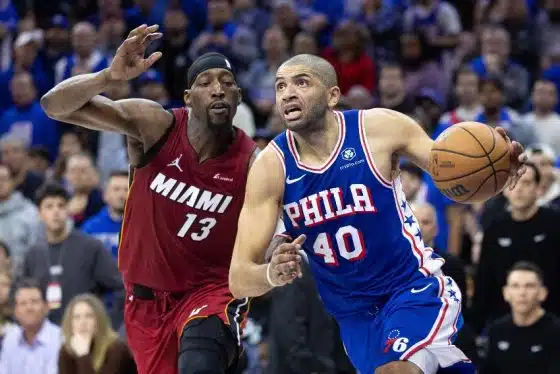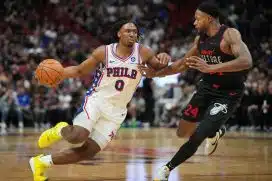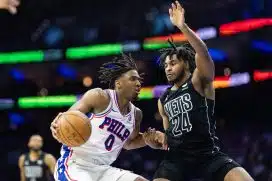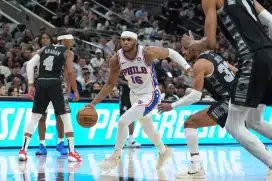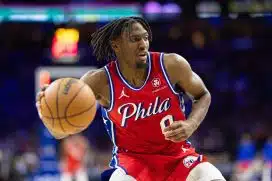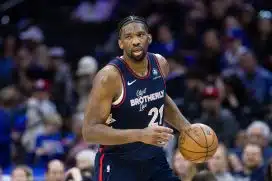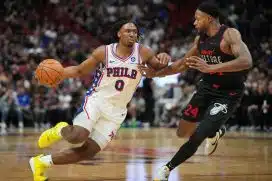By Brandon Apter, Sports Talk Philly editor
For the better part of the last four seasons, the Philadelphia 76ers have been a team in a tank/rebuild phase, putting together a roster of guys with a small chance at winning a large amount of games, winning just 47 games in three seasons prior to 2016-17. Throughout the process, the Sixers' struggles on the court made fans hopeful that the team would find their next franchise star with a high pick in the draft. Philadelphia, over its last four seasons, has selected Joel Embiid, Jahlil Okafor, Ben Simmons and Markelle Fultz and three of guys look to be playing a big part in the future. With a healthy Embiid and Simmons paired with rookie Markelle Fultz and veteran JJ Redick, the tanking years are clearly in the past. There are now expectations after a 28-win campaign last season. Players want to come here.
Many believe that the Sixers set up a pretty good blueprint on how to build through the draft, acquiring expiring contracts for picks and trading players that didn't fit Sam Hinkie's "process" mold. Even though Sam Hinkie is no longer with the Sixers, the assets he built for Bryan Colangelo have been fruitful to say the least, as Colangelo used some of them to acquire the number one overall pick in 2017 from Boston.
The Sixers have some of the best young talent in the league and they pretty much tanked to get there. TJ McConnell even said it on Monday during media day. As of 2019, that benefit through tanking will no longer exist though. On Wednesday, the NBA Board of Governor's passed the long talked about draft lottery reform, set to begin at the 2019 draft lottery. This gives the three worst teams in the league an equal chance to get the top pick and be within the top-3.
Here is an ESPN graphic on how NBA Draft lottery odds change in 2019 pic.twitter.com/Jk8X7q0J3Z
— Adrian Wojnarowski (@wojespn) September 28, 2017
The way the current lottery system works is that the team with the worst record had a 64 percent chance to land a pick within the top three. Now? 40 percent. The team that finishes with the eighth worst record now has a 19 percent chance to get in the top-3, significantly higher odds than the 10 percent it is now.
The worst team in the league now has barely 2x the chance at a top 3 pick than the 8th worst team.
— Derek Bodner (@DerekBodnerNBA) September 28, 2017
The three worst teams now each have a 14 percent chance to get the No. 1 overall pick and 40 percent chance to be in the top-3. In the current system, the worst team had a 25 percent chance at No. 1 and 64 percent in the top-3. With the new system, the odds drop by 20 percent for the worst team to be within the top-3 and 11 percent for the top pick.
According to ESPN, four teams – increased from three – will become part of the lottery draw, which means the No. 1 lottery seed could drop no further than fifth, No. 2 could drop no further than sixth, No. 3 no further than seventh, and No. 4 no further than eighth. One would imagine that smaller market teams would vote against this, since they are already somewhat limited in acquiring elite talent via free agency, so the draft is the route they get the majority of their players to develop. That wasn't the case though as Adrian Wojnarowski tweets that the lottery reform passed 28-1-1 with Oklahoma City voting no and Dallas abstaining.
In conclusion, it's a good thing the Sixers got their tanking/rebuild process started before the lottery reform was finalized. Houston Rockets general manager took to social media, directing a sarcastic tweet at former colleague Sam Hinkie signaling the end of the tanking era.
@samhinkie tanking is solved
— Daryl Morey (@dmorey) September 28, 2017
But hey, Hinkie died for our sins, right?
In addition to lottery reform, the new player resting legislation was passed. Here are the details (via ESPN)…
In the new resting legislation, Silver will have the discretionary ability to fine teams for resting players in several instances, including sitting multiple players outside of unusual circumstances in a single game, and healthy players in nationally televised ESPN, ABC and TNT games.
When teams decide to rest players in games, they'll be encouraged to do so for home instead of away games. Star players sitting out are expected to be on the bench during games and encouraged to be accessible to fans for interaction before the game.
The NBA rid the 2017-18 season schedule of back-to-back games around nationally televised appearances, giving teams presumably less to sit out players for high-profile games.

